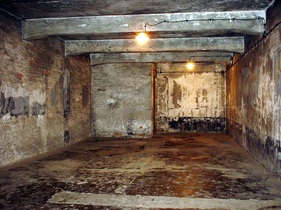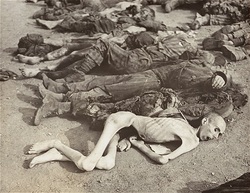The Treblinka Killing Center, one of the many places in Europe where the Nazis took the Jews during the Second World War to be exterminated, was located in a scarcely populated area between the villages of Treblinka and Malkinia. Malkinia was located in the Generalgouvernement (that part of German-occupied Poland not directly annexed to Germany) about 50 miles northeast of Warsaw. In November 1941, the SS and police authorities established a forced-labor camp for Jews, known as Treblinka, later known as Treblinka I. The camp served also as a “so-called” Labor Education Camp for non-Jewish Poles whom the Germans perceived to have violated labor discipline. The majority of the forced laborers worked in a nearby gravel pit. Then, in 1942, the Operational Reinhard authorities completed the construction of a killing center called Treblinka II, approximately a mile from the labor camp.(1) The method the killing centers used for mass murder and extermination of Jews was the use of gas chambers. The gas chambers were, as the name explains, chambers meant to be filled with as many people as possible, and then, with all the people inside, filled with poisonous gas.(2)
Abraham Bomba was one of the unlucky survivors who had to watch it all, all the killings, with a lot of detail. He was raised in Czestochowa, Poland, and then became a Barber. He and his family were deported in 1942 from the Czestochowa ghetto to the Treblinka killing center. At Treblinka, Abraham was selected for forced labor, and was forced to cut women’s hair before they went into the gas chambers. He also sorted the clothes from arriving transports. In 1943, Abraham escaped the camp and went back to Czestochowa, and then worked in another labor camp there from June of the same year until liberation by the Soviet troops in 1945.(3)
Abraham Bomba was one of the unlucky survivors who had to watch it all, all the killings, with a lot of detail. He was raised in Czestochowa, Poland, and then became a Barber. He and his family were deported in 1942 from the Czestochowa ghetto to the Treblinka killing center. At Treblinka, Abraham was selected for forced labor, and was forced to cut women’s hair before they went into the gas chambers. He also sorted the clothes from arriving transports. In 1943, Abraham escaped the camp and went back to Czestochowa, and then worked in another labor camp there from June of the same year until liberation by the Soviet troops in 1945.(3)
In an interview to the United States Holocaust Memorial Museum made in 1990, Abraham talked about his experience in Treblinka, and described the Treblinka gas chambers. According to him, the chambers were all concrete, with no windows, and with nothing inside them. On the ceiling and on the walls, there were wires that, according to Abraham, looked like the water was going to come from them. He said there were two steel doors on opposite sides of the chamber, and the people got inside through only one set of doors. He said that him, as a barber, went into the chamber to do his job, and then it was filled with as many people as possible. Abraham also said that People had to stand with their arms over their heads so there was enough room for everyone, and on top of them the Nazis threw in 2, 3, 4 year old children. Afterwards, the barbers could come out of the chamber. Abraham calculated that the whole gassing process took between 5 and 7 minutes, and then the opposite door from which the people had gotten in opened, and the workers from Treblinka 2 took out the corpses. Abraham remembered that they took out all the bodied, some of them dead, some of them alive, and then they dragged them to the ditches (holes in the sides of the camp) and covered them completely. “That was the beginning of Treblinka”, he finished.(4)
This is a pretty creepy, scary and horrible story in which we, the readers, can see how purely evil the Nazis were. The theme of the story is, in my opinion, the horrible ways in which human beings can use their intelligence. This is a great testimony to see how horrible the Second World War was, and how such terrible acts affected human beings, and it shows us what not to do ever again, because a holocaust goes against everything that could be possibly and remotely moral in the lives of humans. That’s why I think Abraham Bomba’s testimony is possibly one of the most important ones.
BIBLIOGRAPHY:
- "Treblinka." United States Holocaust Memorial Museum. United States Holocaust Memorial Council, 20 June 2014. Web. 4 June 2015. <http://www.ushmm.org/wlc/en/article.php?ModuleId=10005193>
- "Gassing Operations." United States Holocaust Memorial Museum. United States Holocaust Memorial Council, 20 June 2014. Web. 4 June 2015. <http://www.ushmm.org/wlc/en/article.php?ModuleId=10005220>
- "Oral History." United States Holocaust Memorial Museum. United States Holocaust Memorial Council. Web. 4 June 2015. <http://www.ushmm.org/wlc/en/media_oi.php?MediaId=1080>
- "Oral History." United States Holocaust Memorial Museum. United States Holocaust Memorial Council. Web. 4 June 2015. <http://www.ushmm.org/wlc/en/media_oi.php?MediaId=1080>


